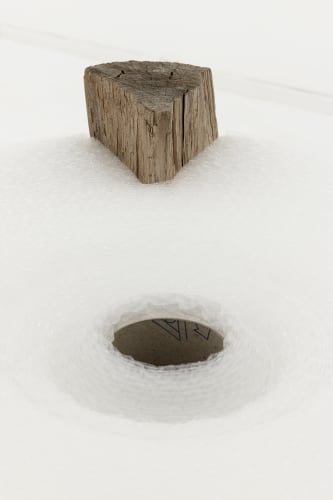Marcel Duchamp continues to be a good starting point for thinking and warning about the present. Although we should avoid mystifying him, he is a complex figure who opened up various avenues of research and thought and this makes us return to him from time to time.
In 1919, Duchamp gave as a gift to his friends the Arnsbergs, who had everything money can buy, a bottle of Parisian air, which he had prepared for them in a pharmacy. With this gesture, he revealed the value of the immaterial and the importance of living and enjoying life over working and producing.
2020-2022: Pep Vidal has delivered to his house an object that he bought online from Great Britain, carefully packaged and protected by bubble-wrap to absorb any blows it might receive during transport. Aware of the global impact of logistical hyperactivity in our interconnected world, Vidal asked himself where the air that protected the object he had purchased came from. Bubble wrap, so widely used today, and so impossible to resist the silly act of popping the bubbles -although we can always dignify it by calling it a Duchampian gesture- is the trigger for an investigation into the physical and conceptual qualities of air.
Duchamp's artistic, conceptual, life-affirming and carefree gesture is transformed by Vidal into a scientific, artistic and socially committed investigation. What is the quality of the air we breathe? Does disproportionate and unsustainable logistics make sense? Who owns the air? Some of these important questions were also raised by the architect Olga Subirós in her project AIR/ARIA/AIRE for the Catalan Pavilion at the Venice Architecture Biennale (2021).
Pep Vidal's answers are not articulated from a theoretical standpoint but rather from scientific methodology. The artist collects, measures, and compares. In this case, he does not draw any conclusions, but instead exhibits the evidence: exhaustive measurements of a glass vase made on the same dates as the one in which Duchamp prepared his ready-made and of a piece of amber from thousands of years ago. He classifies and arranges in methacrylate boxes samples of bubble-wrap from different countries, including bubble-wrap that protected different types of objects, different brands of perfume, and that contained different types of residues. He juxtaposes objects that weigh the same: a small piece of wood and a large roll of bubble wrap. He films clouds that know nothing about borders. He reminds us of the miles that photons must travel to transform into electrons and, in the end, into light.
His scientific methodology and his artistic practice are impeccable. Will we be able to draw the right conclusions? And, most importantly, will we and those able to do so act on them?



